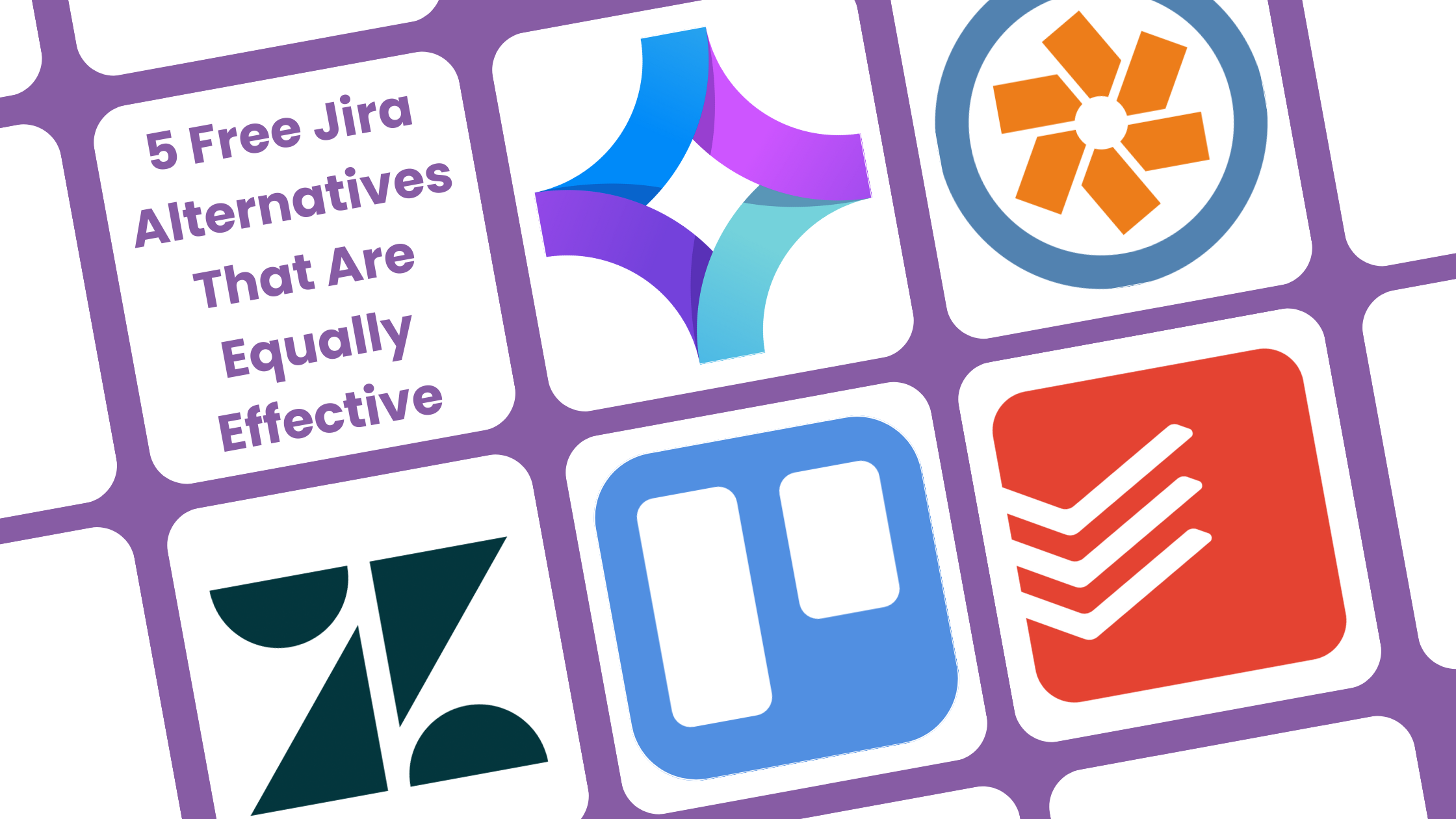
While Jira Software by Atlassian is a powerful tool for development and project management, it might not be the ideal fit for every team. Fortunately, there are several Jira alternatives free of cost that offer robust features and functionalities without the hefty price tag.
Table of Contents
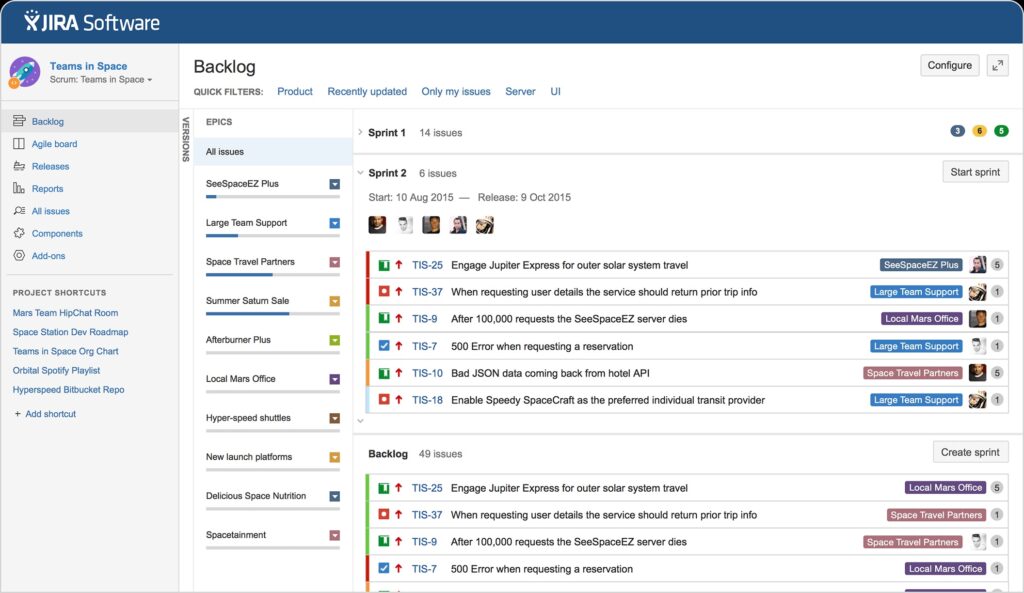
Exploring Free Jira Alternatives
Many teams sought Jira alternatives free to enhance productivity without incurring high costs. Today, Jira offers a free plan for teams with up to ten members. However, this doesn’t diminish the value of other free alternatives.
Before diving into the details of these alternatives, let’s briefly review Jira’s premium plans:
- Standard Plan: $7.75 per user per month, includes up to 250 GB of storage and customer support during business hours.
- Premium Plan: $15.25 per user per month, offers unlimited storage and 24/7 customer support.
- Enterprise Plan: Custom pricing, supports up to 35,000 users, with extensive support and features tailored to large organizations.
Despite these options, exploring other free Jira alternatives can provide a range of features and functionalities that might better suit your team’s specific needs without breaking the bank.
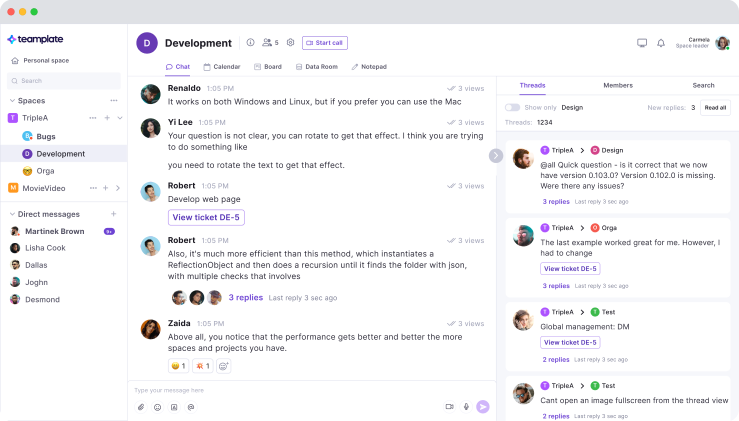
Teamplate: A Comprehensive Free Jira Alternative for Smaller Scale Companies
Teamplate is a user-friendly, all-in-one collaboration tool designed to handle various communication and project management needs for smaller scale companies. Built to compete with tools like Slack, Zoom, Jira, and Confluence, Teamplate consolidates their functionalities into a single platform. This eliminates the need for context switching and allows users to focus on getting things done.
Key Benefits for the Target Audience:
- Boost Productivity: Focus on what matters with reduced app switching, streamlined communication, and features like chat, video calls, and Kanban boards.
- Save Time & Money: Eliminate wasted time searching for information and context switching. Consolidate multiple subscriptions into one for significant cost savings.
- Empower Teams: Foster seamless collaboration with a unified platform for all interactions.
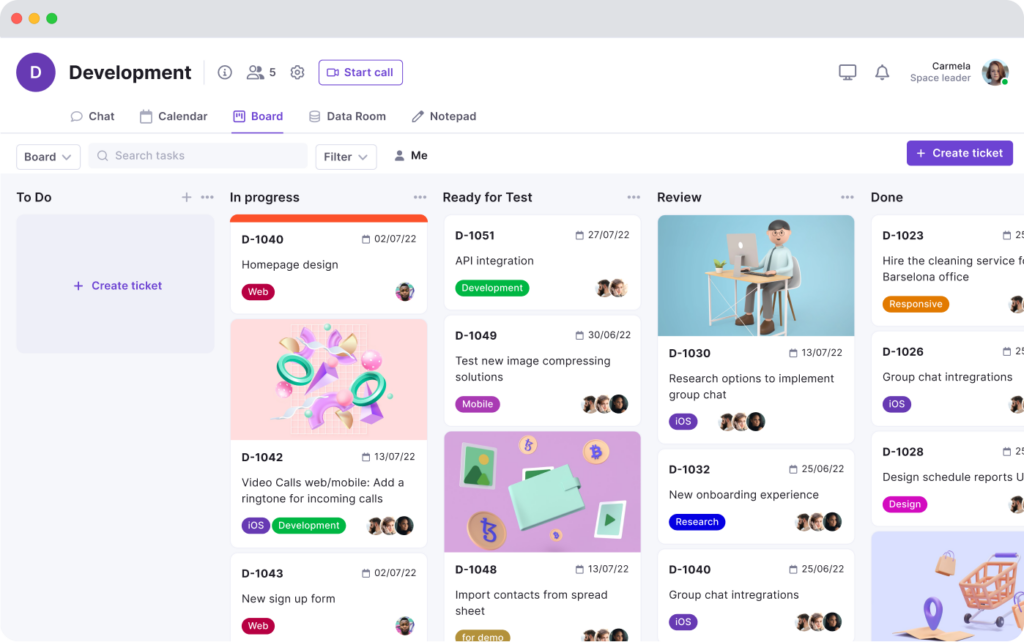
Key Features of Teamplate:
- Chat: Collaborate seamlessly with teams and clients across projects, spaces, and direct messages. Foster real-time collaboration with instant messaging, file sharing, and threaded conversations.
- Video Calls: Connect your team and clients for efficient meetings and collaboration. Teamplate includes built-in screen recording and video call functionality, uniting remote teams and facilitating asynchronous communication.
- Screen Record: Record your screen and upload recordings to chats, tickets, and the data room.
- Kanban Boards: Organize workflows, manage tasks, and visualize progress with customizable boards, epics, and sprints. Switch between backlog, Kanban, and board views.
- Calendar: Stay on top of your schedule and manage meetings with ease.
- Data Room: Securely store, upload, and share various file formats, including Excel, Word, PDF, and images. Set permissions per file.
- Wiki & Notes: Take down ideas and meeting notes and share them with your team in the Wiki. Notes are present across all spaces, visible only to you, and serve as your personal notepad for any and everything.
- Dashboard: Manage your events, tasks, data, and more from a dedicated space.
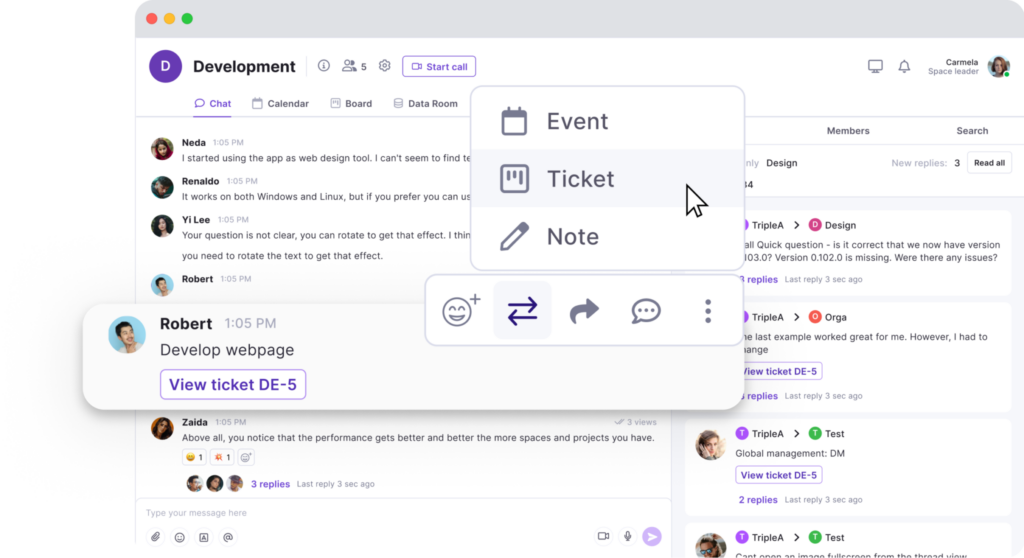
Why Choose Teamplate?
- All-in-One Platform: Eliminate the need for multiple tools and integrations, simplifying your workflow.
- Simple & Intuitive: Easy to use and adopt, minimizing training and onboarding time.
- Affordable & Accessible: Offers a freemium model with all features available, making it an affordable choice for smaller scale companies.
By choosing Teamplate, you can boost productivity, save time and money, and empower your team with a unified collaboration platform that meets all your project management needs. As a free Jira alternative, Teamplate provides extensive features that can help streamline your processes and enhance team collaboration.
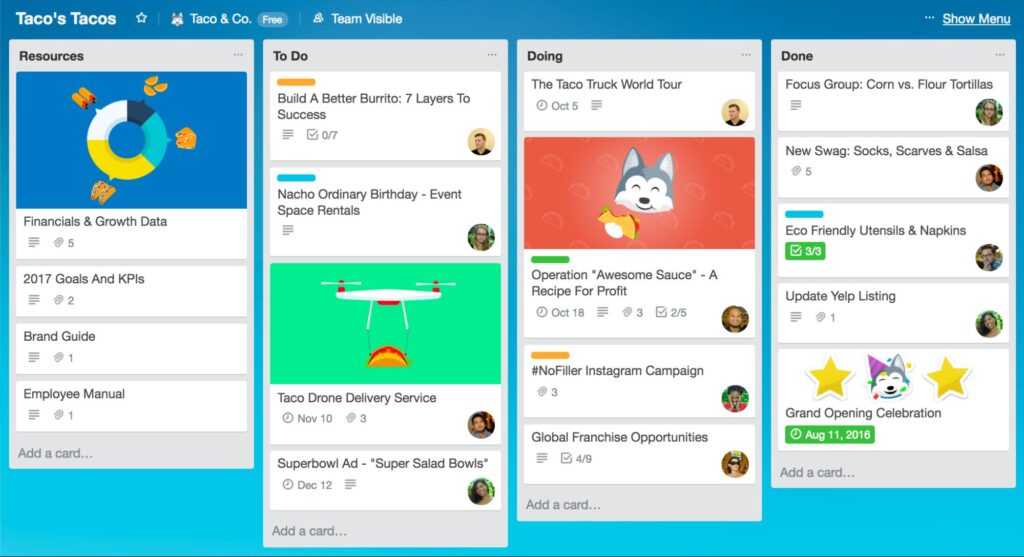
Trello: A Flexible and Simple Free Jira Alternative
Trello has long been favored for its design, simplicity, and overall flexibility. While it may not offer extensive built-in project management features, its openness allows users to create their own systems, making it one of the top Jira alternatives free of charge.
Key Features of Trello:
- Commenting and File Uploading: Facilitate collaboration with commenting and the ability to upload files.
- Drag-and-Drop Organization: Easily organize tasks and projects by dragging and dropping items.
- Integrations: Connect with time-tracking and invoicing apps like Harvest, and other tools via “Power-Ups.”
How Trello Organizes Work:
Trello organizes workspaces into separate boards. Each board contains individual lists, and each list holds individual cards. Users can customize and re-align these elements as they wish, adding any necessary information. This flexibility is one reason why Trello remains a strong contender among free Jira alternatives.
Ownership Note: Trello is owned by Atlassian, the same company behind Jira. Despite this, Trello’s interface has remained largely unchanged, with a slight push towards premium features and integration with other Atlassian products.
Trello Pricing:
- Free Plan: $0 per user per month
- Standard Plan: $5 per user per month (annual plan)
- Premium Plan: $10 per user per month (annual plan)
- Enterprise Plan: $17.50 per user per month (annual plan)
Month-to-month plans are slightly higher, costing $6 and $12.50 for the Standard and Premium Plans, respectively. The Enterprise Plan is only available for annual purchase.
Is Trello Right for You?
For those who already have an established work system or methodology, Trello is an excellent tool for implementing and executing it effectively. It is incredibly flexible, intuitive, and easy to use, making it a good Jira alternative to consider. Trello excels in planning, tracking, and advancing projects in a simple, effective manner, and is also great for team collaboration.
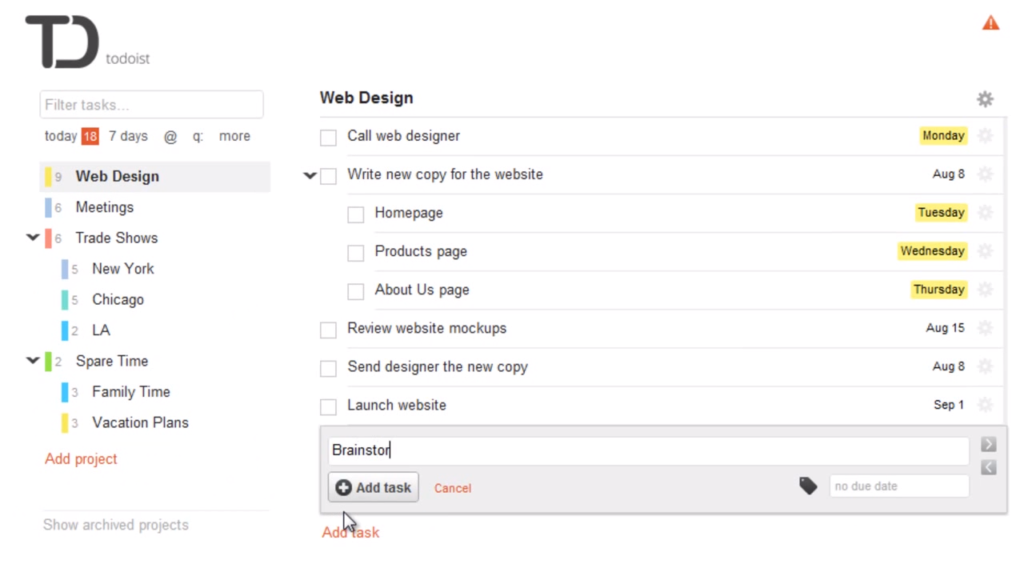
Todoist: A GTD-Friendly Free Jira Alternative
Todoist is one of the main tools that implements the Getting Things Done (GTD) methodology right from the start. Every task in Todoist can be delegated, scheduled, postponed, or moved to a different inbox. Additionally, Todoist supports team collaboration, making it a handy option when considering Jira alternatives free of cost.
Key Features of Todoist:
- Task Management: Delegate, schedule, postpone, or move tasks with ease.
- Team Collaboration: Use Todoist in teams, enhancing productivity and collaboration.
- Cross-Platform Apps: Available for nearly all devices, ensuring seamless task management anywhere.
- Organizational Tools: Organize tasks into individual projects, with support for sub-tasks, sub-projects, recurring tasks, reminders, comments, and task collaboration.
- Productivity Tracking: Track productivity with “karma” scores.
Todoist Pricing:
- Free Plan: $0 per user per month – 5 active projects, 5 people per project.
- Premium Plan: $4 per user per month (annual plan) – 300 active projects, 25 people per project.
- Business Plan: $6 per user per month (annual plan) – 500 active projects, 50 people per project.
Month-to-month pricing is slightly higher, at $5 and $8 for the Premium and Business Plans, respectively.
Is Todoist Right for You?
If your business and projects align with the GTD methodology, Todoist can be an excellent solution. It offers robust task management features, effective project management, and strong teamwork mechanisms. Additionally, the Premium and Business plan upgrades are more affordable than Jira, making Todoist a compelling free Jira alternative.
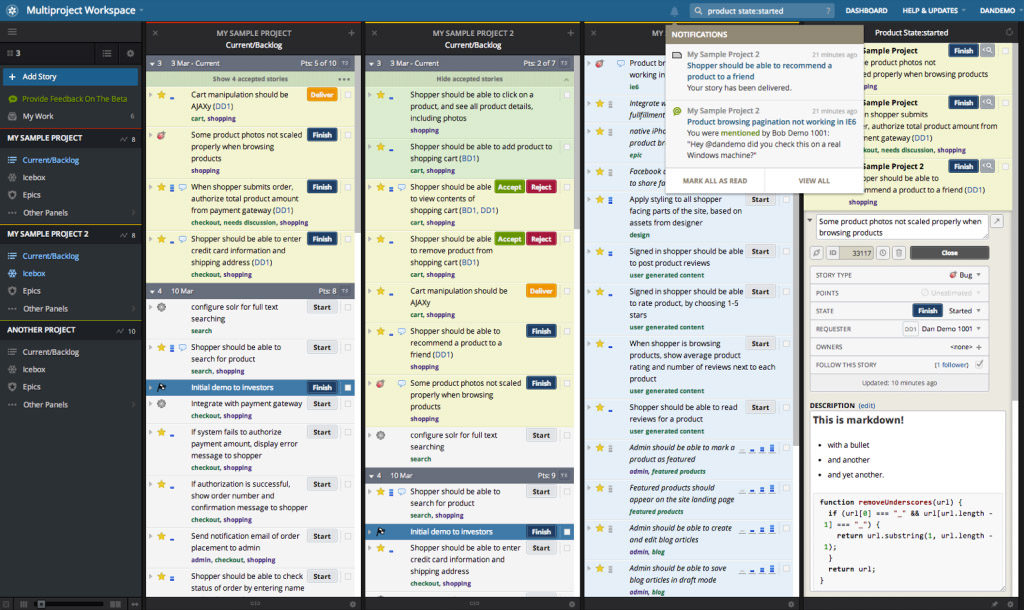
PivotalTracker: A Realistic Free Jira Alternative
PivotalTracker isn’t a direct clone of Jira, but it’s the closest match among the Jira alternatives free listed here. PivotalTracker offers boards, projects, and tasks, but starts by asking users to create “stories.” These can be questions about user requirements on a website or tasks that need completion by a certain deadline. This approach initiates conversations within the organization.
Key Features of PivotalTracker:
- Story Creation: Begin with creating stories to define tasks and project goals.
- Automatic Timeline Calculation: Avoid traditional timelines by automatically calculating your team’s work speed, offering a realistic view of future project potential.
- Structured Interface: Provides a well-organized yet flexible interface for project management.
- Side-by-Side Project Comparison: Compare projects next to each other to understand task completion rates.
- Visual Graphs: View visual graphs to assess team health and project efficiency.
- Excellent Integrations: Integrates with tools like Zendesk, Slack, and GitHub.
PivotalTracker Pricing:
- Free Plan: $0 – 1 to 5 collaborators, 5 projects.
- Startup Plan: $10 per month – 6 to 10 collaborators, unlimited projects.
- Standard Plan: $6.50 per collaborator, per month – 11+ collaborators, unlimited projects.
- Enterprise Plan: Contact for details.
Is PivotalTracker Right for You?
PivotalTracker is ideal for those seeking a realistic planning and project management tool. It offers a classic Kanban board similar to Trello and Jira but enhances workflow automation with accurate project completion predictions. PivotalTracker’s structure and flexibility make it a valuable free Jira alternative for teams wanting to streamline their project management process.
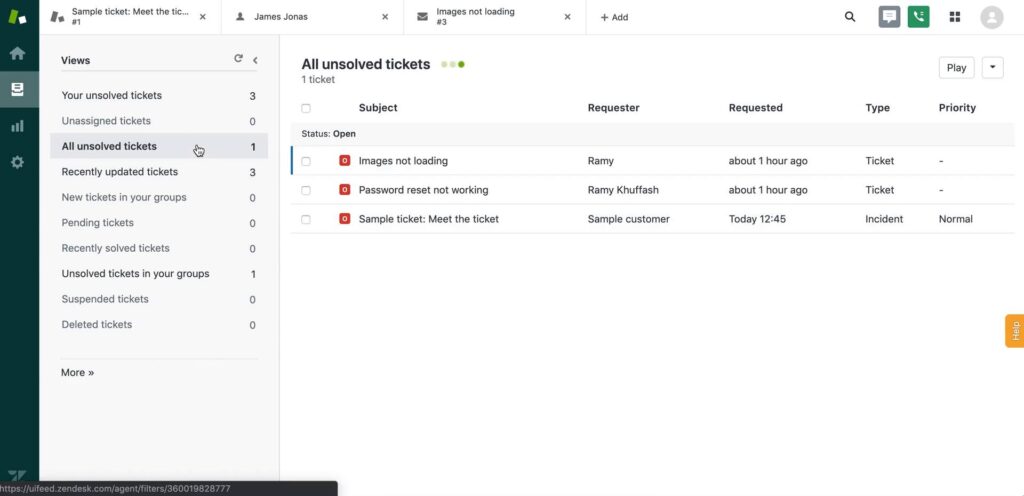
Zendesk: A Top Free Jira Alternative for Customer Support
Choosing the right customer support platform is crucial, as excellent customer support is something you can’t afford to get wrong. Zendesk stands out as a prominent option among Jira alternatives free for those seeking robust customer support capabilities.
Key Features of Zendesk:
- Unified Dashboard: Consolidate support requests from email, chat, social media, and more into a single dashboard.
- Robust Knowledge Base: Ideal for help desk beginners, Zendesk’s knowledge base offers self-service support options to reduce your workload.
- Extensive Reporting and Analytics: Track key metrics and gain insights into agent performance with advanced reporting tools.
Zendesk Pricing:
- Pricing: Starts at $55 per agent per month (billed annually), which is more expensive than some other options but offers extensive features.
Is Zendesk Right for You?
Zendesk is an excellent solution for external customer support teams, particularly those looking for a more user-friendly ticketing system. Its comprehensive dashboard and robust knowledge base make it an ideal choice for providing efficient and effective customer support. For those searching for Jira alternatives free, Zendesk offers a compelling option with its extensive reporting and user-friendly features.
Other Jira Alternatives
While we’ve highlighted some top Jira alternatives free, there are many more options to consider if you’re looking to switch from Jira. Here are some additional tools you might explore:
Developer-Specific Project Management Tools
If you need a project management tool specifically for development projects, consider these platforms:
General Project Management Tools
For those not focused on development, other project management tools might be a better fit:
- Asana: Ideal for team collaboration and task management.
- Trello: Great for visual project tracking and Kanban boards.
- Teamplate: An all-in-one collaboration tool that combines functionalities from Slack, Zoom, Jira, and Confluence, perfect for smaller scale companies looking to boost productivity and streamline workflows.
Budget-Friendly Project Management Platforms
If budget is a concern, explore these free project management platforms:
- ClickUp
- Wrike
- Todoist
- Teamplate: Offers a freemium model with extensive features, making it an affordable and powerful option for smaller teams.
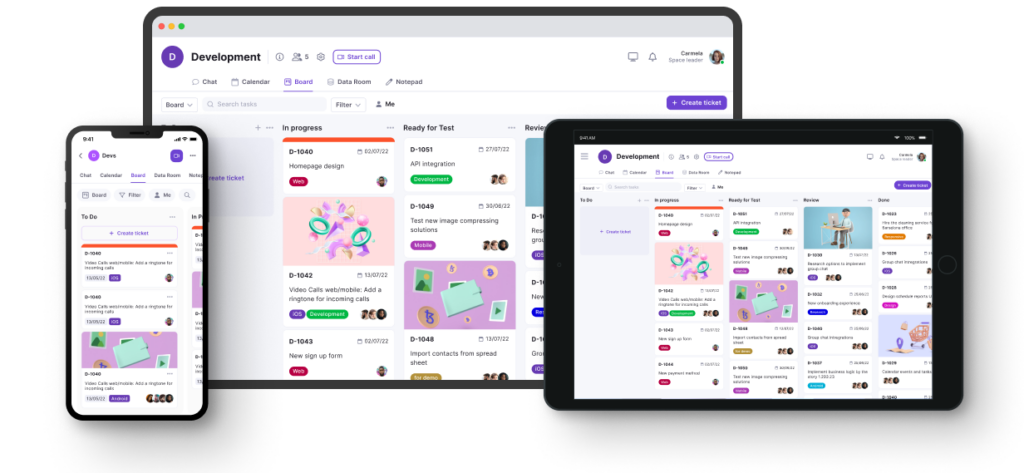
Which Jira Alternative Should You Use?
Before deciding on a Jira alternative, ensure you truly need one. Jira is a robust platform designed for specific teams and use cases, so it’s worth exploring all its features first. If you determine that Jira isn’t the right fit, consider what you primarily use it for—ITSM, project management, Kanban, or customer support—and then choose the right app from the list above.
Teamplate, in particular, is a versatile and user-friendly option that combines various tools into one platform, reducing the need for context switching and enhancing overall productivity.
Project management and team collaboration thrive on clarity and openness. It’s essential that everyone involved is fully informed and in sync .
A key strategy to achieve this is implementing the Kanban framework, renowned for enhancing transparency and streamlining work processes.
This article will introduce you to the Kanban board, a vital tool in this methodology. We will also showcase over 10 outstanding Kanban board examples, providing valuable insights and ideas for your project management endeavors.
Ready to dive in?
Let’s begin.
Table of Contents

What is a Kanban Board?
A Kanban board visually maps out your workflow using columns that denote different stages of a task’s progress. This board is a cornerstone of the Kanban method, an agile approach emphasizing team communication, ongoing enhancement, and openness.
On a Kanban board, tasks are categorized into defined queues such as “To-Do,” “In Progress,” and “Done,” mirroring the specific requirements of your workflow process.
What are the Benefits of a Kanban Board in Project Management?
A Kanban board exemplifies a fundamental yet highly effective method for tracking and managing workflows and tasks. By utilizing various color-coded cards arranged in distinct lanes, this basic Kanban board structure provides a clear and comprehensive view of ongoing projects and their current status.
The primary objective of a Kanban system is to manage and optimize workflow. By setting limits on work in progress, it ensures that team members focus on completing current tasks before embarking on new ones. This approach is crucial in preventing overload and promoting a smooth progression through the workflow.
Continuous refinement and enhancement are at the heart of Kanban, especially relevant for teams in fields like software development and marketing. With each iteration, or ‘sprint,’ teams can assess the pace of task progression, the time taken to initiate tasks, and the frequency of tasks returned for revisions or due to bugs. This ongoing evaluation, a key element of the Lean methodology and encapsulated in the Kaizen system, enables teams – whether in software development, marketing, sales, or other domains – to identify and eliminate inefficiencies, leading to better resource utilization and time management.
The versatility of Kanban boards, including online Kanban board options, allows for adaptation to a variety of team needs, from software development teams to marketing and sales Kanban boards, making them a valuable tool across various sectors.

10+ Project Management Kanban Board Examples
Get your game face on cause we’re about to play our ace by showing you some fantastic Kanban examples.
And if you’re already familiar with the rules of the game, you can start creating an online Kanban board right away – just explore teamplate Kanban board.
1. Project Management
Embarking on project management with a Kanban board isn’t just about organization – it’s about transforming abstract plans into tangible results. The first step is designing a straightforward yet comprehensive board with columns that include:
- Business Requirements
- Ready to Start
- In Progress
- Delegated to Clients
- Done
Incorporating tasks from every department onto your cards, you create a dynamic project management dashboard. This setup not only tracks what each team member is doing at any moment but also offers a panoramic view of the entire project’s progress.
On paper, this structure seems perfect. However, the true challenge lies in bringing this Kanban board to life. Relying on a physical, paper-based system might seem tempting, but in the fast-paced world of project management, this approach is as fragile as a house of cards.
To avoid the pitfalls of outdated methods, it’s essential to leverage the most efficient Kanban tools available. Take Teamplate’s Board, for example, which elevates your Kanban experience with features like:
- Effortless drag-and-drop for moving cards
- Sorting tasks by various criteria such as Status, Assignees, Priority, Tags, and Due Dates
- A comprehensive view of tasks throughout your entire Workspace
- The option to add visually appealing cover images to your cards

2. Product Management
The dynamic world of product development in industries such as SaaS, manufacturing, and software development demands versatile and adaptive management tools. Moving away from the conventional Scrum boards, these sectors are increasingly embracing the flexibility offered by Kanban boards.
Let’s delve into how different product development sectors can tailor Kanban boards to suit their unique processes:
Software Development
Stages on the Kanban board might include
- Design
- Development
- Code Review
- Testing/Quality Assurance
- Deployment
Lean Manufacturing
Here, the Kanban stages could be
- Ordered
- Scheduled
- Manufacturing
- Inspection
- Shipping
- Delivered
SaaS Development
The workflow can be simplified into stages like
- Backlog
- Work in Progress
- In Review
- Done
Kanban boards in product management serve as invaluable tools for tracking and managing critical aspects of product development. They offer real-time visibility, which is especially useful for stakeholders. For instance, when a stakeholder inquires about the status of a product, the software development team can immediately refer to the Kanban board and provide a prompt update. This level of immediacy and transparency is not just convenient; it’s crucial in today’s fast-paced business environments.

3. Real Estate
In the dynamic realm of real estate, a well-structured Kanban board can be a powerful tool for sales agents, enhancing their ability to effectively manage leads, negotiations, and oversee their entire sales funnel. Implementing a Kanban board into your real estate CRM system can revolutionize the way sales processes are handled, offering clarity and efficiency at every step.
Consider incorporating these meticulously designed stages into your sales Kanban board:
- Contacted – marking the initial interaction with potential clients.
- Interested – identifying prospects who have shown interest in the listings.
- Negotiating – the phase where terms and conditions are being discussed.
- Contract Sent – indicating that the official paperwork has been forwarded to the client.
- Contract Received – acknowledging the receipt of the contract by the client.
- Signed – the stage where the client signs the contract, signaling a commitment.
- Deal Closed – the successful conclusion of the sales process.
By integrating these stages into the sales process within your real estate CRM, your team gains unparalleled visibility into the journey of each prospective customer. This structured approach ensures that every lead is meticulously tracked and managed, minimizing the chances of missed opportunities or lapses in communication. Furthermore, this systematic method empowers your agents with the insight to determine the most opportune moments for client engagement. It goes beyond mere transactional interactions and builds towards nurturing a relationship with the client, ensuring contact is made when it is most effective and welcome, rather than at inconvenient times.

4. Construction
Kanban boards serve as a versatile and effective tool for managing and scheduling construction projects of all scales, from small to large-scale organizations. By adopting the Kanban method, construction teams can enhance their project management strategies and streamline their workflows.
Consider, for instance, the construction project lifecycle. This typically encompasses phases like
- Planning
- Initiation
- Bidding and Procurement
- Construction
- Close-out.
By utilizing a Kanban board, each of these phases can be subdivided into more granular, manageable tasks.
Taking the Construction phase as an example, it can be further broken down into specific tasks such as
- Demolition
- Framing Structure
- Pouring Concrete.
These detailed subdivisions on the Kanban board not only make the project more manageable but also provide clear visibility into each stage of the process.
In the context of marketing, a marketing Kanban board can be similarly structured to manage various aspects of a content marketing campaign. For operations teams, an operations Kanban board can streamline processes, from daily logistics to long-term strategic planning. Portfolio Kanban boards can be employed for high-level project overviews, making them an invaluable tool for senior management to oversee multiple projects simultaneously. The real power of Kanban boards lies in their adaptability. Whether you’re creating your own Kanban board from a template or using pre-designed board examples, they can be tailored to suit the specific needs of a project or team. This is particularly beneficial in agile environments, such as agile construction teams or agile marketing teams, where flexibility and responsiveness to change are crucial.

5. Student
For students juggling multiple projects and assignments, adopting an agile Kanban board can be a game-changer. It’s a practical way to organize projects, collaborate on group tasks, and keep tabs on schedules and assignments. With tools like Excel or Google Sheets, creating a personalized Kanban board template is both accessible and effective.
Consider adding these columns to your student Kanban board to efficiently track project progress:
- To-Do: List all pending tasks.
- Subject: Categorize tasks by academic subjects or project titles.
- Assigned Type: Distinguish between individual and group tasks.
- In Progress: Track ongoing tasks.
- Done: Monitor completed assignments.
When facing a substantial project, breaking it down into smaller, more manageable tasks is key. Take, for example, the assignment of reading William Shakespeare’s “Hamlet.” Instead of overwhelming yourself with the task of reading the entire play at once, divide it into segments:
- Read Acts 1 & 2
- Read Act 3
- Read Acts 4 & 5
This approach not only simplifies the task but also provides a clear path to completion.
Group projects can especially benefit from this method. Utilizing a feature like ClickUp’s Multiple Assignees, team members can divide the project into smaller tasks and assign them accordingly. This facilitates clear communication and coordination within the group, allowing each member to track progress and contribute effectively. As a result, the team can ensure that the project is progressing smoothly and is on track for timely submission.
6. Marketing
In the bustling world of content marketing, managing a myriad of tasks ranging from project deadlines to client feedback and campaign advancement is crucial. Without an effective system to track these diverse activities, it’s challenging for marketing teams to gauge their progress and efficiency.
This is where a content marketing Kanban board becomes an essential tool. It enables teams to monitor various activities seamlessly, from website design management to SEO optimization. A well-structured Kanban board for marketing teams might include stages such as:
- Backlog – a reservoir of planned tasks and ideas.
- To-do – tasks that are queued for execution.
- In Progress – current, actively worked-on tasks.
- Pending Approval – tasks awaiting confirmation or feedback.
- Rejected – tasks that require reevaluation or modification.
- Final – completed tasks that have met all requirements.
To enhance this system further, consider integrating an “In Campaign” column. This addition provides real-time insight into active promotions, allowing for prompt adjustments and optimizations.
Moreover, the application of Kanban swimlanes can elevate the organization and clarity of the board. These swim lanes allow for a visual segregation of distinct marketing activities. For instance, one swim lane might be dedicated to “Marketing Metrics,” focusing on analytics and performance tracking, while another could be for “Weekly Newsletter,” streamlining the newsletter creation and distribution process.
7. Weekly Planning
Navigating through the maze of ambitious weekly goals only to find ourselves falling short is a scenario many of us know all too well. The irony is not lost that seven days often leave us feeling, well, weak.
Enter the weekly planning Kanban board, a tool adept at transforming the often chaotic process of agile sprint planning, habit building, and task management into an organized, manageable system. Here’s a streamlined approach to setting up your weekly task board, a tool equally valuable for content marketers, project managers, and team members alike:
- Weekly Goal Setting – at the start of each week, identify and select a handful of achievable tasks from your content marketing Kanban board. This focused approach ensures that you’re not overcommitting.
- Single-Task Focus – adopt a strategy of working on one task card at a time. This method fosters deeper concentration and more efficient task completion.
- Break It Down – for every project task on your card, add subtasks. This breakdown converts overwhelming tasks into smaller, more achievable steps, aligning well with team member specialties and allowing for easier tracking and task management.
- Future Planning with Swimlanes – implement swimlanes on the same board for subsequent weeks, such as weeks two, three, etc. This setup allows for continuous improvement in your planning and provides a clear visual path for forthcoming tasks.
This weekly planning Kanban board not only aids in effective task management but also serves as a guide for project managers and teams to align their efforts with the set objectives. The clarity and structure it brings to the often hectic workweek are invaluable for maintaining focus and driving toward success.

8. Creative and Media Development
When managing complex workflows that involve creative processes, project managers and support teams often face priority conflicts. These challenges are especially pertinent when working across multiple teams and balancing numerous tasks. A practical solution to these challenges is the implementation of several Kanban boards, each tailored to distinct facets of media management.
Let’s explore how Kanban boards can be structured to streamline operations in different areas of media and content management:
Content Creation Planning Kanban Board
This board can track the progression of content from its inception to promotion with stages like
- Requested
- In Progress
- Copy Approval
- Design
- Implementation
- Promotion.
- Such a setup assists project managers in overseeing the entire content creation lifecycle.
Photoshoot Kanban Board
A dedicated board for photoshoot projects could include stages such as
- Concept
- Planning
- Scheduled
- In Progress
- Editing
- Edited
- Delivered
This allows teams to manage each phase of the photoshoot effectively, reducing the risk of priority conflicts.
Content and Social Calendar Kanban Boards
For managing content across various digital platforms, boards could be organized into stages like
- Ideas
- Scheduled This Week
- Scheduled Next Week
- Later This Month
- Published
This structure is particularly beneficial for support teams coordinating content publication across multiple platforms and timelines. These Kanban boards serve not only as tools for tracking the progress of individual tasks but also as platforms for collaborative effort among multiple teams. By clearly defining stages and tasks, they help in prioritizing and resolving conflicts, ensuring that each team member knows their responsibilities and deadlines. The visual nature of Kanban boards facilitates easier communication and a unified approach to project management, essential in the dynamic environment of creative media.
9. Personal Project Management
Kanban boards are not just powerful tools for managing successful projects within a professional context; they can also be incredibly useful for organizing personal projects, from vacation planning to home renovations. While diverse team members in a workplace might use separate boards for various tasks such as the hiring process or product development process, individuals can similarly utilize Kanban boards for their personal planning.
Let’s take vacation planning as an example, even in times when travel may be restricted, like during COVID lockdowns. A personal Kanban board can be a hopeful tool for mapping out future holiday plans. Instead of the typical project-focused columns like to-do, in progress, and done, you can customize your board to fit the nuances of travel planning. Columns might include:
- Admin – for managing bookings, travel insurance, and other administrative tasks.
- Packing – checklist of items to pack for the trip.
- Tourist Attractions – planning and scheduling visits to various sites and attractions.
- Food and Drinks – researching and noting down must-try local cuisine and dining spots.
Incorporating visual elements, such as images of beaches or destinations, into your vacation Kanban board can also add an element of excitement and motivation, especially when physical travel is limited. These images serve as a reminder of the enjoyable experiences that await and can be a delightful contrast to the mundane backgrounds we’ve grown accustomed to in virtual meetings.

10. Event Management
Kanban boards are remarkably versatile and can be a tremendous asset in planning and executing a variety of events, from enchanting weddings to dynamic work functions. Their visual nature and customizable framework make them an ideal tool for event project management.
When creating a Kanban board for event planning, the standard columns – such as To-Do, In Progress, and Done – provide a solid foundation. However, the true magic of Kanban in event planning lies in its ability to be tailored to the specific nuances of event management.
- Custom Columns for Specific Needs – apart from the standard columns, you can add specific ones like “Design Ideas”, “Vendor Contracts”, “RSVPs”, or “Day-of-Event”. These specialized columns allow for tracking different aspects of event planning in an organized manner.
- Visual Inspiration and Confirmation – adding images to your Kanban board can greatly enhance the planning experience. For instance, if you’re organizing a wedding, you can upload pictures of potential flower arrangements, cake designs, and decor themes directly onto the board. This not only serves as a visual reference but also helps in sharing ideas with others involved in the planning process.
- Pending Approval Column – a “Pending Approval” column is particularly useful for tracking items that require confirmation or approval. This can include contracts waiting to be signed, invoices needing clearance, or decisions on venue bookings. Having this column ensures that you’re always aware of what’s awaiting action, preventing bottlenecks in the planning process.
- Collaboration and Updates – for events that involve multiple organizers or stakeholders, a Kanban board can be an effective platform for collaboration. Team members can update the board with new information, track progress, and see at a glance what others are working on. This facilitates clear communication and keeps everyone on the same page.
- Flexibility and Adaptability – as event details can often change, the flexibility of a Kanban board to adapt quickly is invaluable. You can easily move tasks between columns, update details, and rearrange priorities as the planning evolves.
Whether it’s for a family gathering, a corporate event, or a celebratory occasion like a wedding, a Kanban board not only helps in organizing the myriad details involved but also makes the process more engaging and less overwhelming. It transforms the daunting task of event management into a more structured and enjoyable journey.
11. Human Resources
Investing in high-quality Kanban software apps can significantly transform the operations of an HR department, steering it away from the frantic pace often associated with fire-fighting to a more organized, efficient state. Here’s why incorporating a Kanban board into HR practices can be a game-changer:
- Streamlined Recruitment Process – an HR Kanban board can revolutionize the hiring process. Recruiters can visually map out each stage of recruitment, from initial application screenings to final interviews and offers. This clarity allows for tracking the progress of each candidate effectively, ensuring no one slips through the cracks.
- Enhanced Candidate Retention – by organizing and prioritizing tasks on the Kanban board, recruiters can respond more promptly to candidates, keeping them engaged and interested. This timely communication is key in retaining top talent, especially in competitive job markets.
- Maintaining Recruiter Sanity – the organized nature of a Kanban board can significantly reduce the stress and chaos that often accompany recruitment. By having a clear overview of all ongoing processes, recruiters can manage their workload more effectively, leading to a less frenetic, more controlled work environment.
- Improving Candidate Experience – the efficiency brought about by the Kanban system directly impacts the candidate experience. Faster response times, transparent communication, and a streamlined process make for a more positive interaction with potential employees. A smooth and professional recruitment process reflects well on the company’s brand and increases the likelihood of candidates accepting offers.
- Collaboration and Visibility – kanban boards foster better collaboration among team members. Everyone in the HR team, from recruiters to hiring managers, can view the progress of various tasks and understand their roles and responsibilities in the recruitment process. This shared visibility promotes a cohesive team effort and reduces the chances of miscommunication.
- Continuous Improvement – with the Kanban methodology, there’s always room for refinement. HR teams can regularly review and adjust their processes, responding to changes in the recruitment landscape or internal company policies. This adaptability is crucial for maintaining an efficient and effective hiring process.
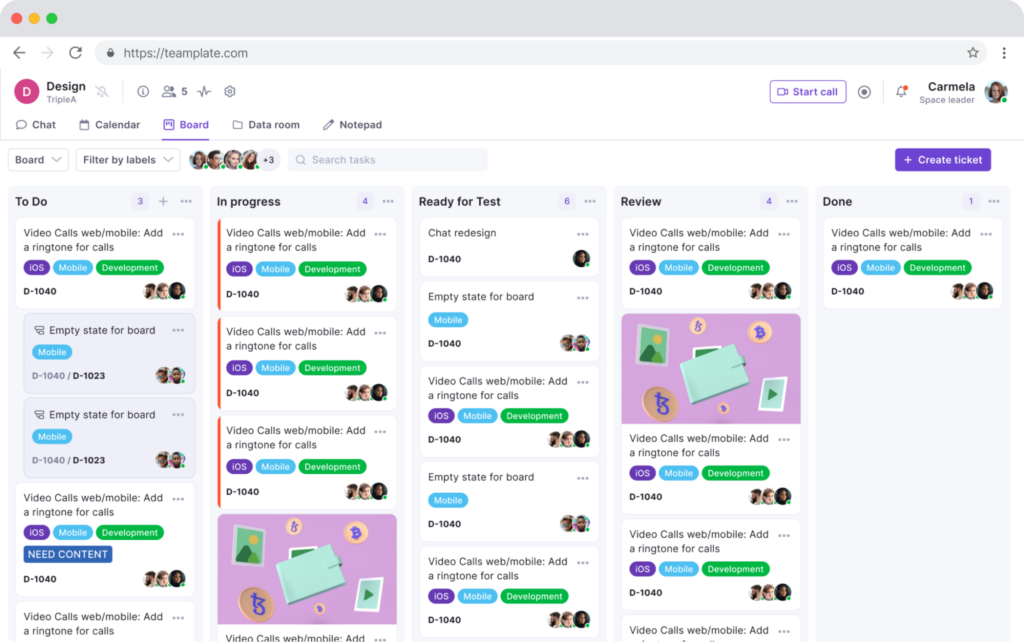
Conclusion
The adoption of a Kanban board in various departments, particularly in HR, can lead to transformative changes in efficiency, communication, and overall workflow management. The benefits of utilizing such a system are extensive: from streamlining recruitment processes to enhancing candidate experience, and from maintaining team sanity to fostering continuous improvement.
For organizations looking to implement this system, Teamplate offers a robust Kanban board solution that is worth exploring. Their platform is designed to cater to the diverse needs of different teams and projects, making it an ideal choice for those seeking to enhance their productivity and organizational capabilities. By integrating Teamplate’s Kanban board into your workflow, you open up opportunities for greater collaboration, transparency, and efficiency. It’s a step towards not just organizing tasks but optimizing entire processes, ensuring that your teams are working at their best and delivering exceptional results.

Maintaining efficiency and organization in the fast-paced corporate environment of today is not only advantageous, but also essential to success.
This is where business management software comes into play, giving contemporary companies the tools they need to improve efficiency and streamline processes. But the obstacle for a lot of startups and small enterprises is usually the high price of purchasing all-inclusive software solutions.
These costs may pose a serious obstacle, making it more difficult for them to successfully compete with bigger companies.
In this piece, we explore the world of free all-in-one business management software and how these tools can help small businesses run more efficiently than their more affluent competitors.
They also offer a cost-effective solution for these businesses. Knowing the possibilities of these software programs may be the key to increasing productivity and propelling your company ahead, regardless of size.
Table of Contents
The idea of free all-in-one business management software has surfaced as a revolutionary answer to this problem. Various tools for optimizing different parts of a business are included in this program, which is seamlessly integrated into one platform.
In the midst of the daily flurry of business activity, it helps teams keep on top of their work and guarantees that nothing is missed. Business management software is essential for streamlining internal operations and building a customer knowledge base.
It does this by facilitating tasks, project collaboration, time monitoring, and process documentation.
However, what precisely is software for company management? Fundamentally, it is a collection of software, hardware, and applications that let an organization control, automate, and enhance its operations.
Comprehensive features like customer relationship management, cloud storage and data management, enterprise project management, business metrics tracking, invoicing and budgeting, analytics and reporting, and workflow automation are all part of what makes the best business management software, which goes beyond the essentials.
10 Top All-in-One Business Management Softwares
What constitutes the finest company management software varies from person to person.
To assist you in selecting the best company management platform for your requirements, we’ve listed the most widely used ones.
Now let’s get going!
Teamplate
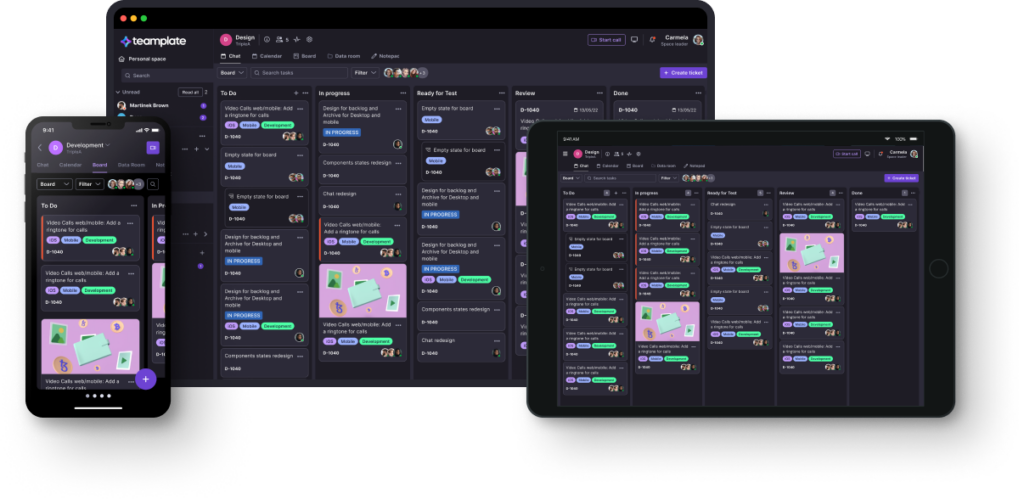
Teamplate sets itself apart as a flexible project management solution praised for its wide range of advanced capabilities. These carefully designed features make it easier to handle tasks, allowing for the effective administration of different project components like as sprints, epics, and checklists. This novel method raises the bar for organization and execution and completely changes the way teams approach project management. Fundamentally, Teamplate provides a wide range of functionalities that enhance project management with both precision and efficiency. This powerful system can easily accommodate teams of various sizes, enabling them to work on projects with remarkable precision and agility. Beyond the fundamentals of project management, Teamplate provides a unified platform that changes with the needs of teamwork and project advancement.

Key Features:
- With Teamplate, teams can easily create and manage epics, which gives them a clear picture of how their project is progressing and helps them to fully comprehend their objectives.
- Teamplate’s sprint feature highlights how important timing is to project management, enabling teams to break up their work into smaller, more manageable chunks and focus on particular tasks for predetermined amounts of time. This strategy helps to monitor project progress in addition to increasing efficiency.
- By incorporating agile approaches, Teamplate goes beyond basic tools and empowers teams to flourish in hectic project environments.
- Teamplate’s user-friendly design puts job management ahead of feature complexity, making it an excellent option for businesses of all sizes.
- The checklist feature of Teamplate takes a meticulous approach to work division, guaranteeing close monitoring and control.

Advantages of Teamplate:
- The harmonious combination of sprints, epics, and checklists offers unparalleled project management flexibility while reducing project execution uncertainty.
- Teamplate’s per-user price approach is flexible enough to accommodate small teams as well as large organizations, and it meets a wide range of business needs.
- Adopting agile methodologies ensures prompt adaptation to changing project circumstances.
- Simple interfaces are easier to use and encourage quick adoption.
- Uses technologies made especially for efficient communication and group decision-making to encourage cooperation.

Pricing:
- Available as a ‘Free Forever’ plan.
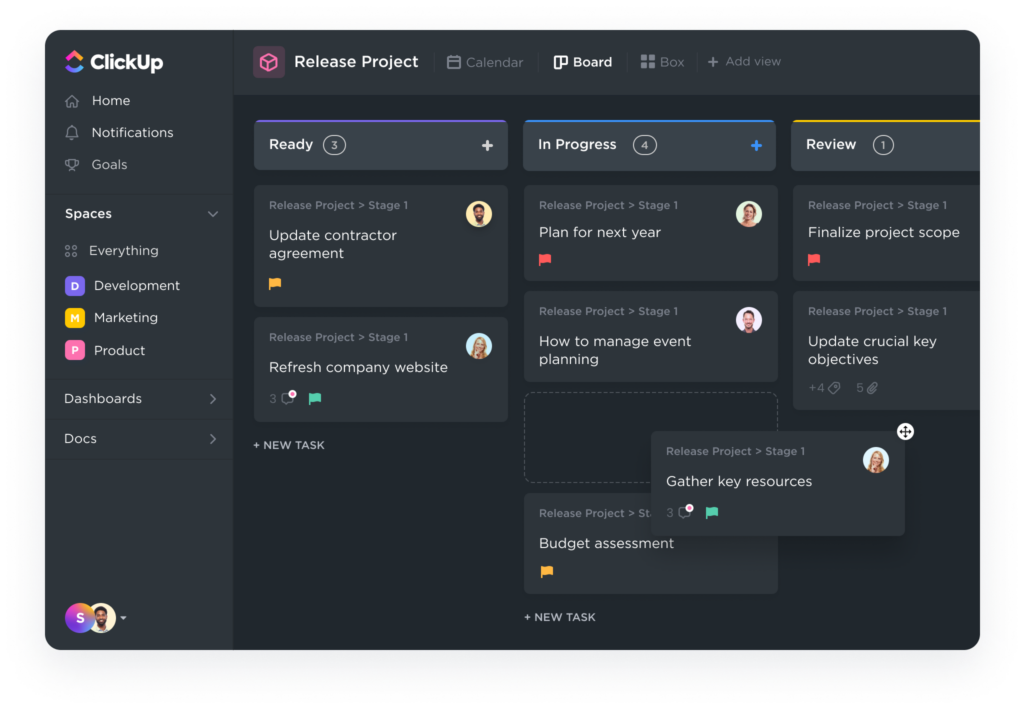
Clickup
In the dynamic realm of modern business, the right tools can make all the difference. Business management software has become an indispensable asset for companies aiming to streamline their operations and enhance productivity. Among these tools, ClickUp emerges as a versatile and powerful project management tool, ideal for a range of business environments. This enterprise business management software offers adaptability and robust features, making it suitable for varied teams—from software companies with multifunctional groups to agencies collaborating with clients.
ClickUp is more than just free CRM software; it’s a comprehensive project management solution designed to boost speed and efficiency across teams. Its array of potent features is tailored to improve time management and workload distribution, making it an invaluable asset in the toolkit of any efficient business.
Advantages of ClickUp:
- Highly Adaptable Dashboards – the software’s dashboards allow team members to easily visualize and organize their daily tasks, enhancing resource management and task prioritization.
- With ClickUp, setting and tracking organizational objectives and milestones is streamlined, thanks to its functionality for organizing OKRs (Objectives and Key Results) coupled with real-time progress reporting.
- A vast selection of pre-designed templates is available, catering to a variety of tasks and needs. These templates can be personalized to fit specific project requirements and to automate workflows effectively.
Limitations of ClickUp:
- New users may find there’s a learning curve to fully exploit all the advanced functionalities that ClickUp offers.
- The free version of this free business management software is limited to 100MB of storage, a limitation that can be removed with an affordable upgrade.
Pricing:
- Free Forever Plan: Offers basic functionalities for individuals or small teams.
- Unlimited Plan: Priced at $5/month per user, suitable for small to medium-sized teams.
- Business Plan: At $12/month per user, this plan is ideal for larger teams needing advanced features.
- Business Plus Plan: Priced at $19/month per user, offering additional functionalities for complex needs.
- Enterprise Plan: Custom pricing is available for this plan, designed for large organizations with extensive requirements.

Trello
In your quest for efficient business management tools, you might have stumbled upon Trello, renowned for its effectiveness in project and task management. Trello has gained popularity for its user-friendly interface and straightforward approach, making it less intimidating than many other project management software options. It’s particularly noted for its capacity in task management and its utility in streamlining business operations.
Advantages of Trello:
- Trello provides a platform for automating various business processes with its extensive community and template library.
- The software allows for numerous integrations, enhancing its functionality and adaptability to different business needs.
- Stay productive on the go with Trello’s mobile applications, designed for ease of use and efficiency.
- Trello’s pricing structure is reasonable, offering good value for the features it provides.
Limitations of Trello:
- Trello may not be as flexible for larger teams looking for more complex task management solutions.
- The reporting functionalities are somewhat basic, which might be a drawback for businesses needing in-depth analytics.
- The free version comes with limited storage, which could be a constraint for businesses with larger data requirements.
Pricing:
- Free Forever: This tier offers unlimited cards, up to 10 boards per team, 10MB file size per upload, custom backgrounds, mobile app access, and 250 workspace command runs.
- Standard: Priced at $5/user/month, it includes unlimited boards, 250MB per file upload, saved searches, custom fields, advanced checklists, and single-board guest access.
- Premium: At $10/user/month, it adds multiple views (dashboard, timeline, map view, and table views), priority support, and simple data exports.
- Enterprise: For $17.50/user/month, it provides organization-wide permissions, public board management, and multi-board guest access.
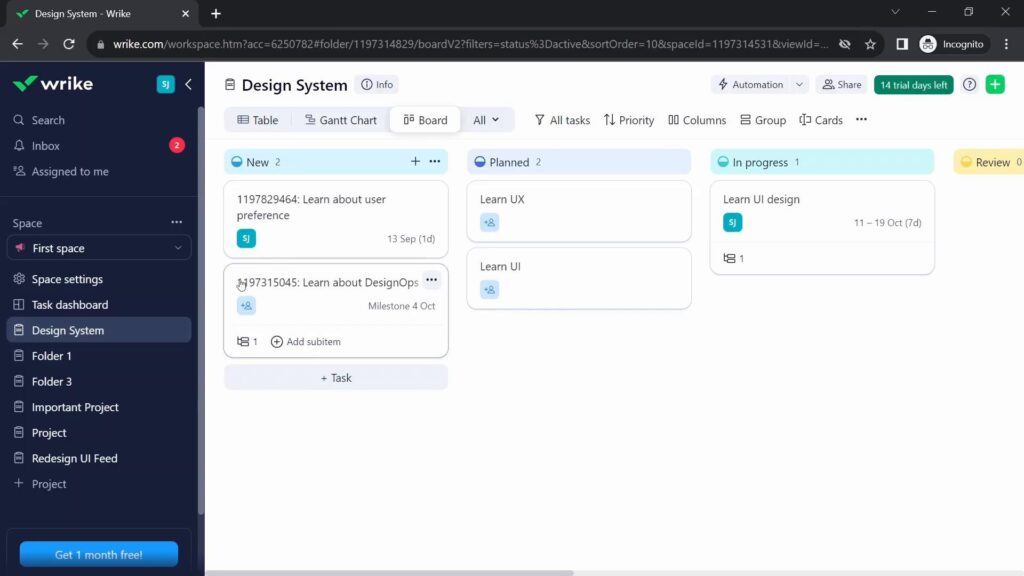
Wrike
In the realm of business software, especially for those seeking solutions in business process automation and task management, Wrike emerges as a notable contender. This cloud-based management software is tailored to enhance team workflows and foster better collaboration. It stands out as a versatile platform, combining the functionalities of a free office suite with robust project management tools.
Advantages of Wrike:
- Wrike excels in offering detailed task management capabilities, enabling businesses to create, assign, and monitor tasks across various projects and teams efficiently.
- With over 400 integrations, Wrike can seamlessly blend into any business’s existing software ecosystem.
- It provides in-depth reporting features, offering valuable insights into project performance and progress.
Limitations of Wrike:
- The feature-rich interface of Wrike might be overwhelming for new users, particularly those unfamiliar with complex management software.
- Some users might find the customization options in Wrike to be somewhat restricted.
Pricing:
- Free Tier: Wrike offers a free software version, making it a great entry point for small businesses or teams new to business software.
- Team Plan: Priced at $9.80/month per user, this plan is designed for smaller teams seeking more functionality.
- Business Plan: At $24.80/month per user, this tier is suitable for businesses needing advanced project management features.
- Enterprise and Pinnacle Plans: These plans offer custom pricing and are ideal for large organizations requiring extensive project management capabilities and support.
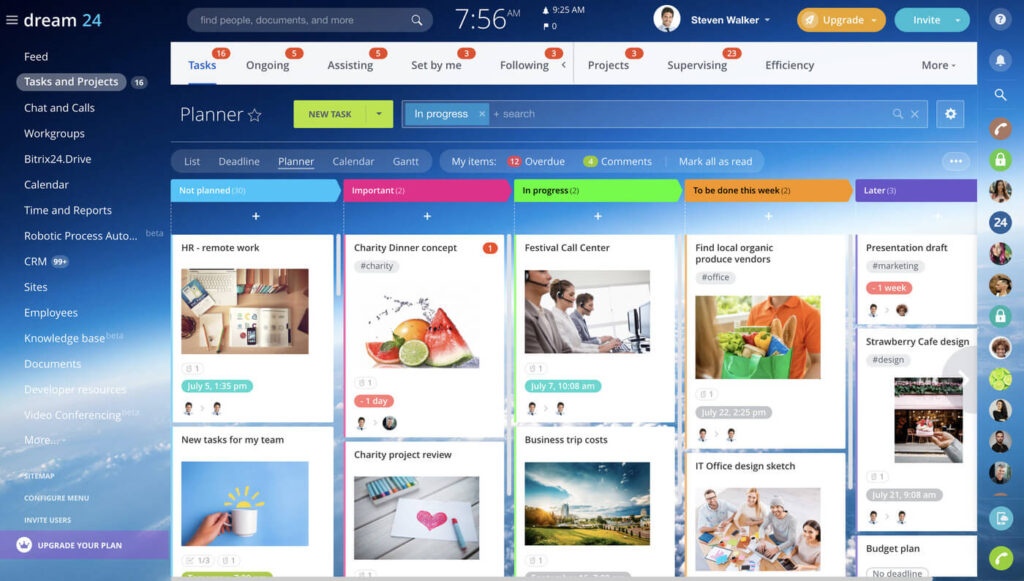
Bitrix24
Bitrix24 stands out in the landscape of business software, offering an all-in-one solution for project management, CRM insights, and HR practices automation. Central to Bitrix24 are its capabilities in communication, CRM, and collaboration, making it a comprehensive management tool. It’s particularly notable for its versatility, aligning with the needs of various business functions, from task management to small business accounting software.
Advantages of Bitrix24:
- Offering total control over data and source code, along with the ability to develop native tools, Bitrix24’s self-hosting option is a standout feature for businesses seeking more autonomy.
- Users can create, assign, and monitor tasks and projects effortlessly from a single dashboard, streamlining task management processes.
- Track employee timesheets, manage leave requests, and generate reports with ease, making HR tasks more efficient.
- Make calls, host video conferences, or chat with customers directly within Bitrix24, enhancing CRM capabilities.
Limitations of Bitrix24:
- Recurring Tasks and Project Templates – In the free version, the ability to create recurring tasks and access project templates is unavailable.
- New users may find the interface complex, potentially requiring a learning curve.
- While the free version offers a range of tools, it comes with limitations in storage, speed, customization, and responsiveness, especially noticeable in the website builder feature.
Pricing:
- Free forever plan: Includes unlimited users, basic collaboration tools, task and project management, CRM functionalities, and 5GB storage – positioning it as one of the best free CRM software options.
- Basic Plan: Priced at $49/month for 5 users, this plan expands storage to 24GB and adds more features including project management, contact center, and an online store.
- Standard Plan: At $99/month, it extends the free plan offerings to 50 users, along with enhanced support and 100GB storage.
- Professional Plan: For $199/month, it provides unlimited users, advanced sales intelligence, and extensive business process automation and HR automation features, along with a significant storage boost to 1024GB.
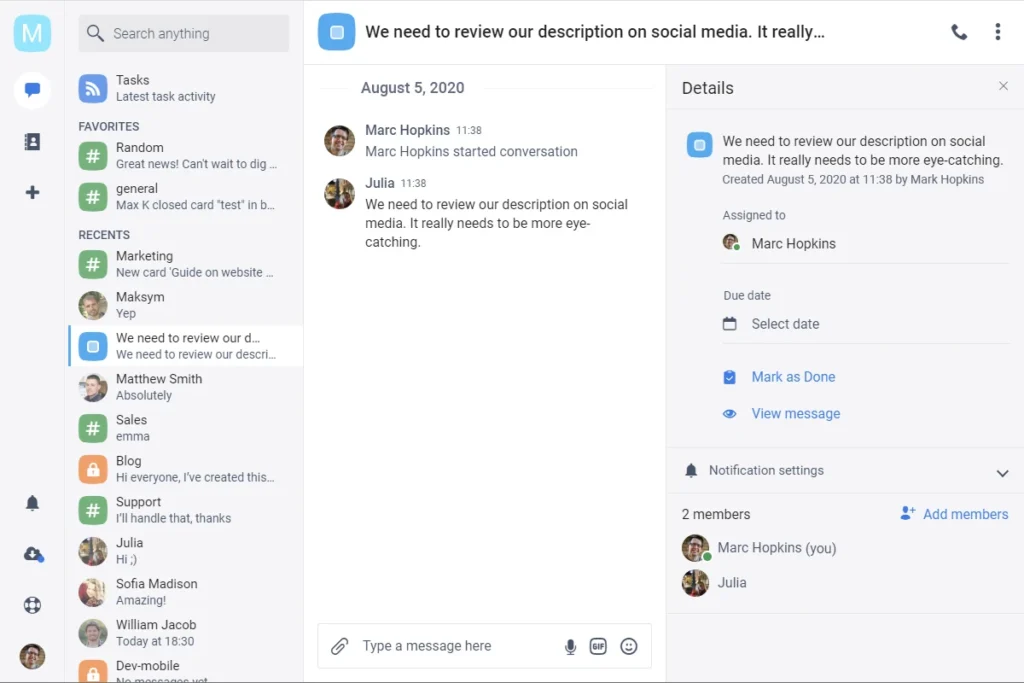
Chanty
Chanty stands out as an exemplary team collaboration tool, specifically designed to enhance team productivity through streamlined communication. Renowned for its simplicity and effectiveness, Chanty facilitates not just team conversations, but also extends its capabilities to essential areas like document management, making it an ideal choice for teams focused on key performance indicators and business performance.
Advantages of Chanty:
- Centralized Teambook Dashboard – this feature allows for the effective organization of tasks, conversations, and files, simplifying document and file sharing within teams.
- Prioritize and highlight crucial deadlines, ideas, and tasks, ensuring that vital information is always readily accessible.
- The tool offers the flexibility to set roles, permissions, and privileges, which is vital for contact management and maintaining team hierarchy.
- Chanty’s user interface is designed for simplicity, making it super easy to tailor to the evolving needs of a business.
- With just a few clicks, team members can turn messages into actionable tasks, a key feature for those looking to manage projects efficiently.
Limitations of Chanty:
- Screen Sharing in Free Plan – one notable drawback is the absence of screen sharing in the free plan, which might be a constraint for teams that rely heavily on visual collaboration.
- The tool offers limited task view choices, restricted to Kanban and calendar options, which might not cater to more complex project management needs.
- The free version does not allow setting roles and permission controls, which can be a limitation for larger teams or those requiring detailed hierarchy management.
Pricing:
- Free Plan: Ideal for small teams, this plan is free forever and includes unlimited conversations, basic task management features, supports up to 10 members, allows 1 guest user, and offers up to 10 integrations.
- Business Plan: Priced at $3/user/month, this plan expands the offerings with unlimited group video calls, allowance for 3 guests per member, a dedicated support line, and unlimited integrations.
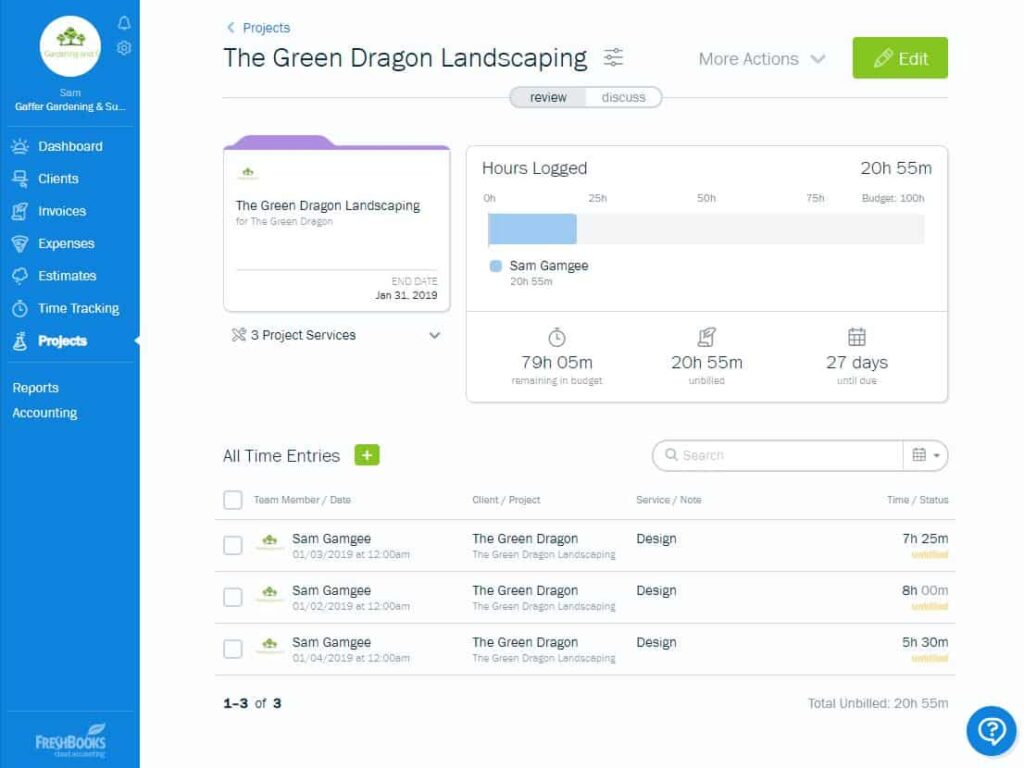
Freshbooks
Tax season often brings a sense of dread for many self-employed individuals and solopreneurs, with the complexities of financial management and accounting looming large. In such scenarios, cloud-based accounting solutions like FreshBooks become a beacon of relief. Regarded as one of the best free software for basic accounting needs, FreshBooks is particularly favored by small businesses and freelancers for its efficiency in tracking billable time and managing financial tasks.
Advantages of FreshBooks:
- Diverse E-commerce Integrations- ideal for businesses using platforms like Squarespace, eBay, Shopify, etc., offering seamless integration for e-commerce accounting.
- Online Payment Acceptance – a crucial feature for freelancers working with global clients, simplifying the payment process.
- Create invoices and send automatic reminders for late payments with just a few clicks, ensuring efficient contact management.
- Manage invoicing and track expenses from anywhere, a handy tool for busy freelancers and business owners.
- Provides a more comprehensive view of business finances and performance, essential for financial planning and analysis.
Limitations of FreshBooks:
- While FreshBooks offers some reporting functions, its capabilities in forecasting and expense estimates are not as advanced as some other solutions.
- Not Ideal for Large Inventory Management – businesses with significant inventory management needs may find FreshBooks lacking in this area.
- Restricted Collaboration Features -the software offers limited functionalities for chat and collaboration on projects.
- The number of billable clients is limited in certain pricing plans, which might be a constraint for businesses as they expand.
Pricing:
- Lite: At $15/month, this plan includes 5 billable clients, unlimited expense tracking, and sales report tracking.
- Plus: Priced at $25/month, offering services to 50 billable clients, this plan adds features like automatic receipt data capture, recurrent billing, client retainers, and the ability to invite an accountant.
- Premium: For $50/month, it caters to unlimited clients and includes all features in the Plus plan, along with customized email options and business health reports.
- Select: This custom pricing plan offers capped ACH fees, a dedicated account manager, accounts for 2 team members, and automatic expense tracking.
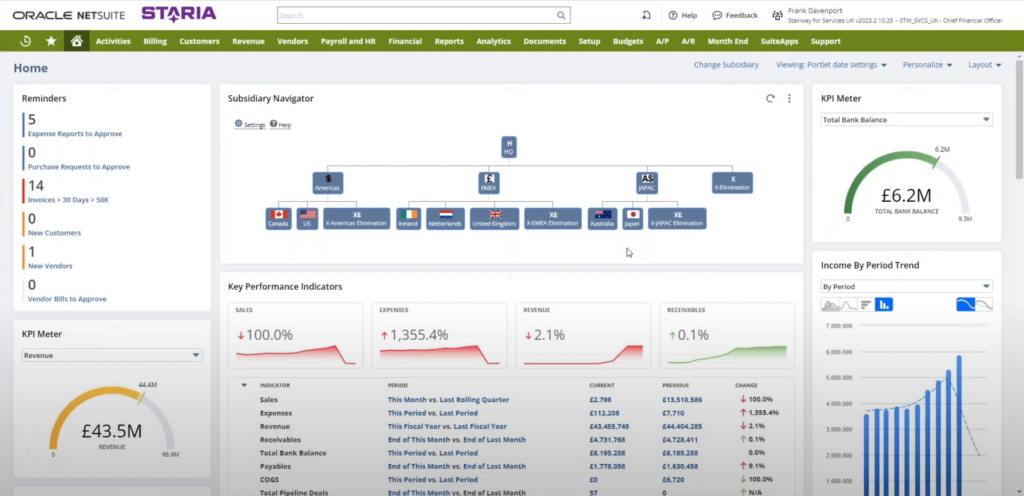
Netsuite
Netsuite distinguishes itself as a versatile ERP software and comprehensive business management platform, adeptly supporting businesses through various stages of growth. This cloud-based enterprise platform is not just a solution for CRM and financial management; it’s also an efficient tool for e-commerce operations. Its ability to centralize business processes on a single server makes it a centralized platform of choice for many enterprises.
Advantages of Netsuite:
- Netsuite excels in streamlining business operations with automated workflows, enhancing both efficiency and consistency.
- The platform provides robust business intelligence capabilities, crucial for making informed decisions as a business expands.
- Its centralized platform offers a unified dashboard to manage and monitor financial and operational performance.
- The flexibility to have various features open simultaneously caters to modern multitasking demands, enhancing the user experience.
Limitations of Netsuite:
- Occasionally, Netsuite may remove certain features, impacting users who relied on them.
- While Netsuite offers basic features, some essential add-ons come at an additional cost.
- The platform’s complex documentation process can be daunting for new users.
- The mobile experience on Netsuite is somewhat limited, which might be challenging for users who need on-the-go access.
Pricing:
- Custom Pricing: Netsuite’s pricing is customized to meet the specific needs of each business, necessitating direct inquiries for detailed information.
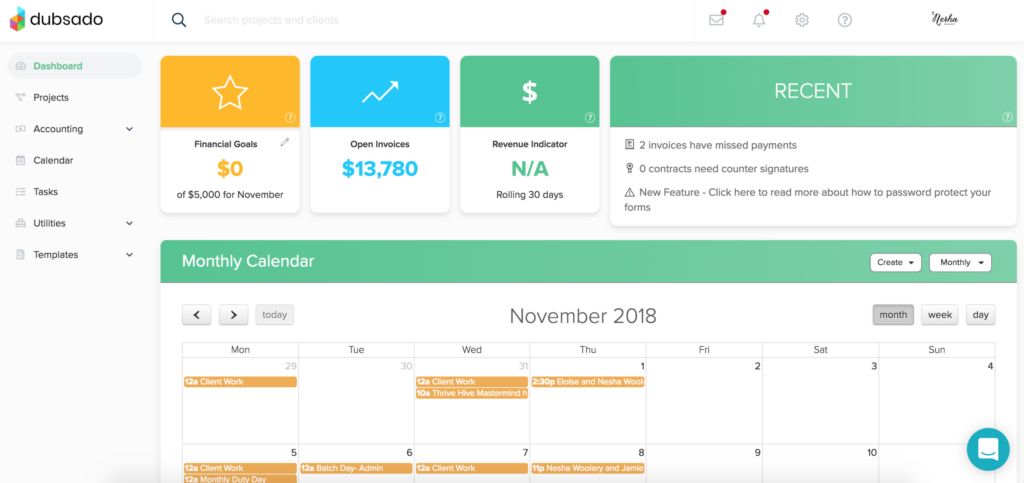
Dubsado
Dubsado presents itself as a versatile and comprehensive platform, expertly designed to streamline operations and manage CRM. This platform is a boon for teams seeking to maintain a seamless workflow, with features that cater to everything from project management to scheduling appointments. With its range of tools, Dubsado stands out for helping businesses make the best-informed purchase decisions.
Advantages of Dubsado:
- Integrated Client Management – utilize integrated emails, client portals, and task boards for efficient client relationship management.
- Features for recurring payments and reminders automate and simplify the financial aspects of your business.
- The scheduler allows clients to easily book calls through your website, enhancing client engagement.
Limitations of Dubsado:
- Restricted Document Sharing – the platform limits document sharing to within project workspaces, posing a challenge for wider collaboration needs.
- New users may require time to familiarize themselves with all the features Dubsado offers.
- The absence of a mobile app can limit accessibility for users who need to manage tasks on the go.
Pricing:
- Starter Plan: Offered at $200/year, it includes unlimited projects and clients, form and email templates, along with invoicing and payment functionalities.
- Premier Plan: At $400/year, this plan adds automated workflows and unlimited lead capture forms to the Starter plan’s features.
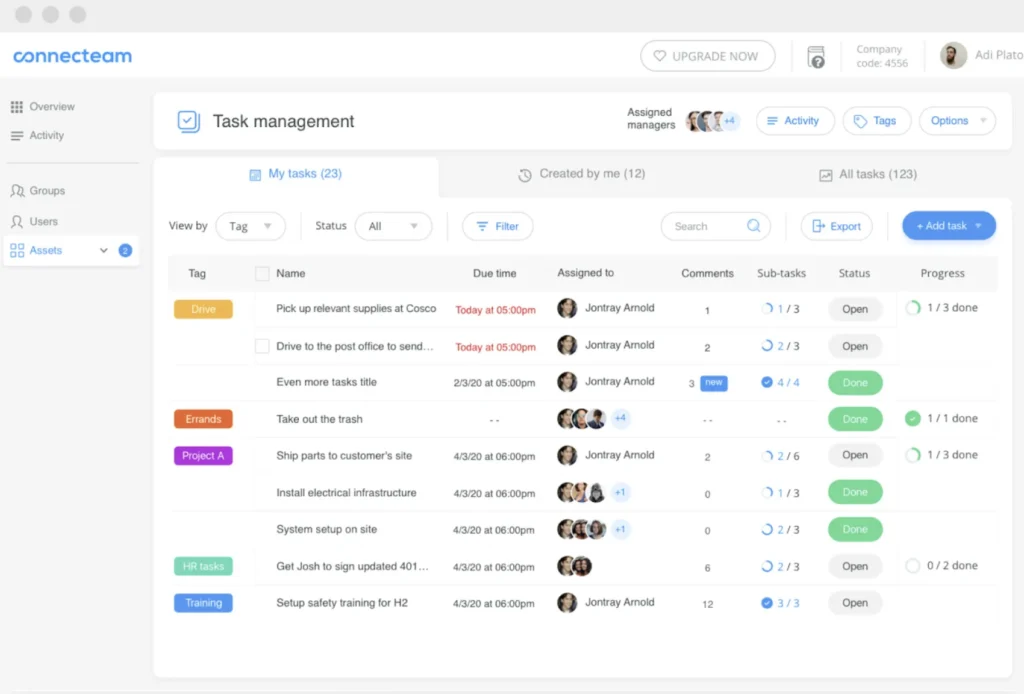
Connecteam
Connecteam emerges as a dynamic, mobile-centric software solution, designed to enhance business management and field service efficiency. It’s especially crafted for businesses seeking a robust system to manage teams, whether they’re in-office, remote, or field-based. This platform is distinguished by its comprehensive suite of features, such as free templates, sophisticated email marketing capabilities, and precise time tracking tools, enabling businesses to create unique solutions tailored to their needs.
Advantages of Connecteam:
- End-of-shift reports encourage management and staff to work together.
- You can efficiently track staff performance with the aid of the time clock tool.
- Messages shared by the entire team allow for easy communication with them.
Limitations of Connecteam:
- Large amount of customizations that can be overwhelming
- Data is segmented between different parts of the app, forcing you to have to go to a new screen to find what you need
- In areas with poor internet connectivity, the software’s performance can slow down
Pricing:
- Small Business Plan: Free, ideal for startups and small teams.
- Basic Plan: $29/month for up to 30 users, suitable for growing businesses.
- Advanced Plan: $49/month for up to 30 users, designed for businesses needing broader features.
- Expert Plan: $99 for up to 30 users, best for large enterprises requiring full-scale functionalities.
Conclusion
Teamplate stands out as an intuitive platform that not only streamlines workflow but also significantly enhances your team’s productivity in managing various business activities. This comprehensive tool encapsulates everything needed for effective business management, from enabling collaboration to automating processes and facilitating smooth communication.
With its focus on providing key features that support business applications, Teamplate ensures that your team can capitalize on sales opportunities more efficiently. Its integration with systems like QuickBooks Online simplifies online payments, making financial management a breeze. Moreover, its adaptability with mobile apps offers the flexibility to manage teams and marketing campaigns on the go.
By adopting Teamplate, you’re not just investing in a tool; you’re making the best informed purchase decision for your business’s future. Experience firsthand how Teamplate transforms the way your team operates, ensuring that your business is well-equipped to handle the dynamic demands of the modern world. Embrace Teamplate to streamline your workflow today and propel your business to new heights of efficiency and collaboration.

